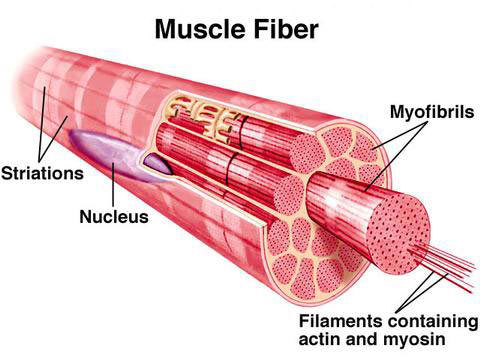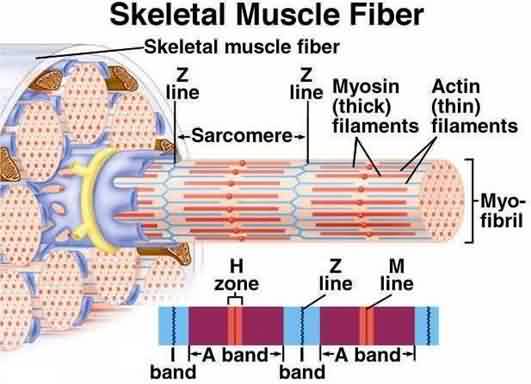
Muscle-Skeletal Muscle-Gross and Ultra Structure
Muscle
- The word muscle is derived from Latin word “musculus” which means little mouse. It is named so because of the movement of muscle under the skin resembles a running mouse. Joints make a skeleton potentially movable and bones provides a basic system of levers but bones and joints cannot move by themselves. The driving force behind the movement is the muscle.
There are three types of muscles
- Smooth muscle
- Cardiac muscle
- Skeletal muscle
1. Skeletal muscle
- Skeletal muscle is attached to bone and helps in movement. It is also known as striated muscle because the muscle fibers shows alternate dark and light band under light microscope. Muscle are usually in a partial contracted state which give muscle tone and make ready for contraction under the stimulus preceding a complete contraction.

Figure: Skeletal muscle fibre
Gross structure:
- Muscle is composed of muscle cell, which are called as muscle fibres because they are so long, cylindrical shape multi nucleated cell more resemble to fibre than cell. They are arranged parallel to each other.
- Each fibre is multimucleated and the nucleus are located near the surface of each fibre.
- Bundle of fibres are surrounded by collagen fibres and connective tissues.
- Each muscle fibres is enclosed by a plasmamembrane called Sarcolemma.
- The cytoplasm is known as sarcoplasm which contain large number of mitochondria.
Ultra structure:
- Muscle fibre is composed of large number of myofibril arranged parallel to each other. Around each myofibril, a network of sarcoplasmic reticulum runs parallel forming transverse tubules (T-tubules).
- Close examination of myofibril shows it is composed of two types of longitudinal filaments.
- Thin filament is made up of actin protein whereas thick filament is made up of myosin protein.
- These myofilament are arrange in such as a way that they form alternate dark and light band.
- The dark band is formed where actin and myosin interlocked each other, called A-band. The light band between the A-band formed by actin only known as I-band.
- Cutting across I-band is Z-line.
- Within an A-band there is somewhat lighter H-zone which contain only myosin.
- Extending across H-zone there is a delicate M-line, which connects adjacent myosin filament.
The distance between Two Z-line represents a fundamental unit for muscle contraction known as Sarcomere.

